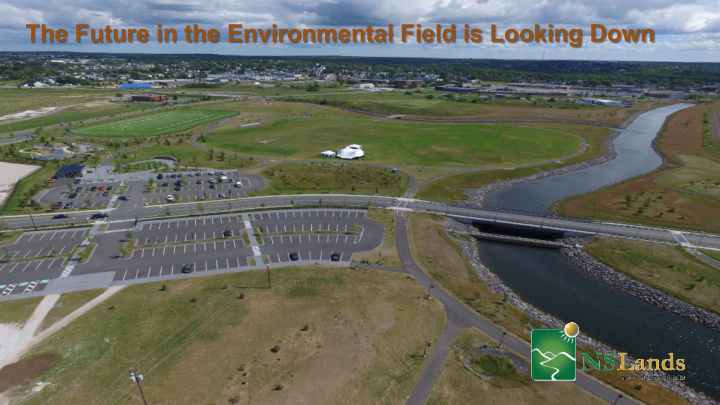



The Future in the Environmental Field is Looking Down
Aerial Photography’s Origins The first known aerial photograph was taken in 1858 by French photographer and balloonist Gaspar Felix Tournachon (aka- Nadar). Nadar patented the idea of using aerial photographs in mapmaking and surveying, but it took him 3 years Of experimenting before he successfully produced the very first aerial photograph.
Aerial Photography’s Origins Kites used in 1882 Pigeons used in Germany in 1903 Rockets used in 1897 by Alfred Nobel
Aerial Photography’s Origins First photograph from an airplane in 1909 by Wilbur Wright Fairchild created first aerial map of Manhattan Island in 1921. First non- military purpose aerial photograph with Widespread commercial success.
The Future in the Environmental Field is Looking Down Drone Technology Drones have become the newest, fairly low-cost and effective tools for environmental practitioners and property managers.
What are drones? • Unmanned aerial vehicles (UAVS), also known as drones, are aircraft either controlled by ‘pilots’ from the ground or increasingly, autonomously following a pre-programmed mission. While there are dozens of different types of drones, they basically fall into two categories: those that are used for reconnaissance and surveillance purposes and those that are armed with missiles and bombs. A British Military Magazine “Dronewars.net” Definition
Different Sizes
Different Shapes
Different Sensors
What we’ve mostly heard about drones before today? • Drones have been used as effective military weapons • Military reconnaissance • Delivery to your door!!
Recreational Aircraft Do’s and Don’ts Do’s • Fly your aircraft during daylight and in good weather (not in clouds or fog). • Keep your aircraft in sight, where you can see it with your own eyes – not only through an on-board camera, monitor or smartphone. • Make sure your aircraft is safe for flight before take-off. Ask yourself, for example, are the batteries fully charged? Is it too cold to fly? • Know if you need permission to fly and when to apply for a Special Flight Operations Certificate • Respect the privacy of others – avoid flying over private property or taking photos or videos without permission .
Recreational Aircraft Do’s and Don’ts Don’ts • Closer than 9 km from any airport, heliport, or aerodrome. • Higher than 90 metres from above the ground. • Closer than 150 metres from people, animals, buildings, structures, or vehicles. • In populated areas or near large groups of people, including sporting events, concerts, festivals, and firework shows. • Near moving vehicles, avoid highways, bridges, busy streets or anywhere you could endanger or distract drivers. • Within restricted airspace, including near or over military bases, prisons, and forest fires. • Anywhere you may interfere with first responders
Emerging Regulations • UAV Pilot Training Certificate
The sky’s the limit! What uses do you envision? Environmental, Engineering, Property Management, Construction, Disaster Response
How do they fit our field? • Drones are now at a price point Take video and that makes them economically Lightweight still photography efficient • Geo-referencing and Max. Height light landmarking makes pictures Purchase for commercial 500 under $1,500 more technically useful meters • Easy to use safely and Easily controlled effectively within established 2 km range on with GPS small guidelines reference commercial (home)
Some present uses Engineering Disaster Response + Civil Engineering Design Mapping + Search and Rescue + Asset monitoring (Bridge maintenance • Environmental + Marine Search and Rescue needed?) + Wildfire + Photogrammetry Services + Flooding • + Land cover mapping + Measurements (Lidar Services) + Damage assessment + Carbon capping + Digital elevation modeling + Rapid response / 911 + 3D Feature extraction / Contour + Renewable energy + Emergency Uses (delivery of equipment generation e.g. Defibrillator) + Environmental Monitoring + Surf Lifesaving (floatation delivery) + Thermographic Imaging (dumping) + Fire Detection (e.g. fire towers) + Lidar Services + Waterway Monitoring Mining / OIL & GAS + Ice Flow Monitoring Construction / Pre-construction + Oil spill tracking + Parks (Asset management) + Pipeline monitoring + Virtual view from new + Wildlife Conservation + Environmental assessment construction (Vantage Point) + Conservation drones + Pit Survey + Aerials documenting whole + Wildlife counts / Mapping of site animal population Miscellaneous + Construction Planning – Identify + Natural History Surveys + Anti-Poaching potential issues. GPS/time/mapping. + Marine Biology – Whale health + Construction Progress + Image Geo-referencing Monitoring monitoring + Google map & Google + Marketing for Construction earth mapping + Surveying + Marine Algae bloom and Proliferation Detection
Thermal Imaging by Drone Wildlife Surveillance Plume Monitoring Fire “Hot Spots” “Wilder” Life Surveillance
Environmental Monitoring Pollution Monitoring Nest Relocation
Our UAV • Need – Initial uses were primarily promotional and marketing • Search – Staff researched what was out there and at what cost. DJI Phantom 3 Professional was determined best bang for buck for us. Examined issues like fly-aways; ease of use; technical requirements; etc … • Budget - Established a preliminary budget of $1500 to get us into market • Sourcing – Fairly soft market, locally. Priced online through three local large chain outlets. • Procured – Purchased our through Staples based on cost/availability and supplier
Our UAV • Technology– Purchased IPOD Mini with WiFi & Cellular Ability • Pilots – Staff had to train via DJI Users Manual • Insurance - $100,000 liability insurance required • Manual – Includes Transport Canada Exemption; Insurance Verification; Release Notes/Update Records; Quick Start Guide; User Manual; Pilot Training Guide; Key literature • Reference – NAV Canada “Canada Flight Supplement” • SFOC Applications
Our uses to date! Resource Monitoring Property Inspection Cap Monitoring
Event Planning/Marketing Flags of Remembrance Sydney RibFest Action Week Fireworks OHP
Sydney River Dam
Wharf Inspections Pictou Wharf
Tank Inspections TIR Tank Marconi Campus Harbourside Commercial Park Standpipe Grand Lake Water System Tank
Port Mersey
Boat Harbour
The Future in the Environmental Field is Looking Down Questions/Comments Donnie.Burke@novascotia.ca
Recommend
More recommend